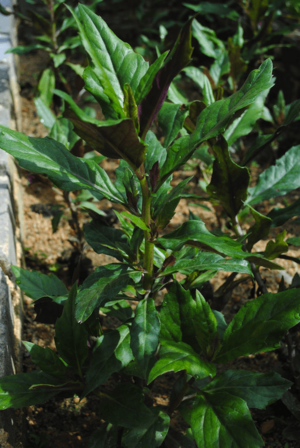Gynura bicolor facts for kids
Quick facts for kids Gynura bicolor |
|
|---|---|
 |
|
| Hongfeng cai 紅鳳菜 plant | |
| Scientific classification | |
| Genus: |
Gynura
|
| Species: |
bicolor
|
| Synonyms | |
|
|
Gynura bicolor, also known as hongfeng cai (紅鳳菜), Okinawan spinach, or edible gynura, is a plant from the chrysanthemum family (Asteraceae). It originally comes from China, Thailand, and Myanmar. However, people now grow it in many other places because it's a tasty vegetable and a useful herb for traditional medicine.
There are two main types of Gynura bicolor. One type has green leaves on both sides. The other type has green leaves on top and a beautiful purple color underneath. Both kinds are thought to have good health benefits. This plant is a perennial, which means it grows back year after year. You can find it for sale all year round, but it's usually best to use it in winter and spring.
Contents
History of Gynura Bicolor
People have used Gynura bicolor as food and in folk medicine for thousands of years. It was first brought to a special garden called the Calcutta Botanic Garden in 1798. It came from the Maluku Islands in eastern Indonesia.
Later, in the 18th century, it was brought to Japan. By 2010, Japan was growing and selling a lot of it, with about 63 tons being shipped!
What's Inside Gynura Bicolor?
Gynura bicolor is packed with good stuff for your body! It has lots of Vitamin C, protein, and iron. It also contains carotenoids, which are good for your eyes, and calcium, which helps your bones. Plus, it's a great source of essential amino acids and anthocyanins, which are special plant colors that are good for health.
How People Use Gynura Bicolor
In China, people think Gynura bicolor is a 'cool' food. To balance this, they often stir-fry the leaves with sesame oil and ginger, which are considered 'hotter' foods. You can also make tea from the stems and roots of the plant. When you pick leaves, try to choose ones that don't have many bruises or black spots.
In Japan, Gynura bicolor is a popular local vegetable in places like Ishikawa, Kumamoto, and Okinawa. They might lightly boil it and serve it with ponzu sauce. It's also used in miso soup or made into tempura, which is a crispy fried dish.
The roots of the plant have even been studied for use by astronauts! They are rich in Vitamin K, which can help with bone health. This might be useful for astronauts in space, as their bones can weaken.
How to Grow Gynura Bicolor
It's super easy to grow Gynura bicolor! You can simply take cuttings from an existing plant, and they will grow into new plants.
Is Gynura Bicolor Safe?
Some studies have looked into whether Gynura bicolor has any harmful substances. A type of chemical called pyrrolizidine alkaloids has been found in some plants from China. These chemicals can be bad for the liver if you have too much. However, most studies show that the plant generally has very low levels of these chemicals.
One study found that the plant was mostly safe when eaten. It didn't harm normal cells and was considered safe for eating. This study also suggested that the plant might even help protect against certain health issues.
It's always a good idea to eat Gynura bicolor in normal amounts, just like any other food. This helps make sure you get all the good benefits without any possible risks from the low levels of those chemicals.
See also
 In Spanish: Gynura bicolor para niños
In Spanish: Gynura bicolor para niños

